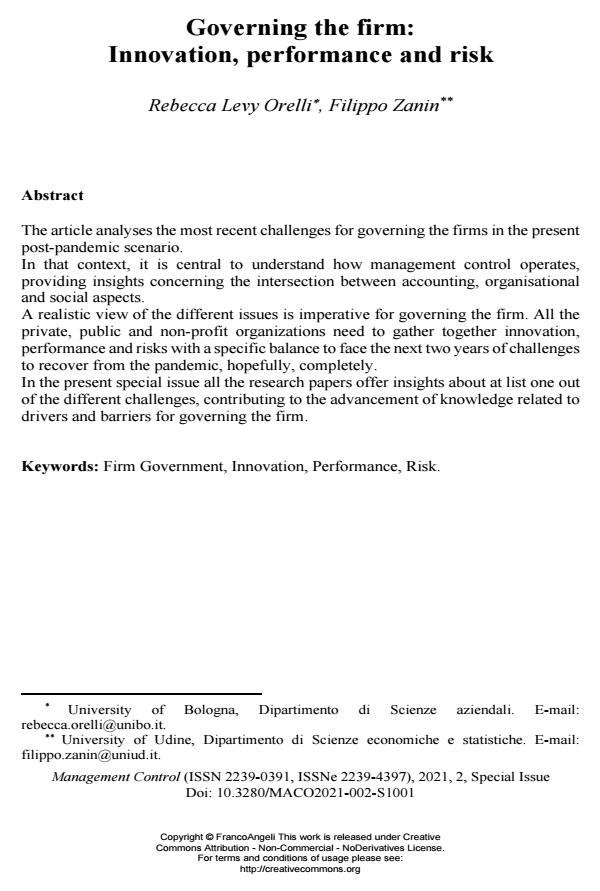Governing the firm: Innovation, performance and risk
Titolo Rivista MANAGEMENT CONTROL
Autori/Curatori Rebecca Levy Orelli, Filippo Zanin
Anno di pubblicazione 2021 Fascicolo 2021/suppl. 2 Lingua Inglese
Numero pagine 10 P. 5-14 Dimensione file 173 KB
DOI 10.3280/MACO2021-002-S1001
Il DOI è il codice a barre della proprietà intellettuale: per saperne di più
clicca qui

FrancoAngeli è membro della Publishers International Linking Association, Inc (PILA)associazione indipendente e non profit per facilitare (attraverso i servizi tecnologici implementati da CrossRef.org) l’accesso degli studiosi ai contenuti digitali nelle pubblicazioni professionali e scientifiche
The article analyses the most recent challenges for governing the firms in the present post-pandemic scenario. In that context, it is central to understand how management control operates, providing insights concerning the intersection between accounting, organisational and social aspects. A realistic view of the different issues is imperative for governing the firm. All the private, public and non-profit organizations need to gather together innovation, performance and risks with a specific balance to face the next two years of challenges to recover from the pandemic, hopefully, completely. In the present special issue all the research papers offer insights about at list one out of the different challenges, contributing to the advancement of knowledge related to drivers and barriers for governing the firm.
Keywords:Firm Government, Innovation, Performance, Risk.
- Arcari A., Pistoni A., Moretto E., Ossola P., Tonini D. (2016), How Italian companies are monitoring innovation, Management Control, 2, pp. 143-165. DOI: 10.3280/MACO2016-002007
- Avina J. (1993), The Evolutionary Life Cycles of Non‐governmental Development Organizations, Public Administration and Development, 13(5), pp. 453-474.
- Barbetta G.P., Anheier H.K., Hwang C., Salamon L.M. (1993), Defining the nonprofit sector: Italy. Working Paper of The Johns Hopkins Comparative Nonprofit Sector Project. Johns Hopkins Institute for Policy Studies. -- Retrieved from http://ccss.jhu.edu/wp-content/uploads/downloads/2011/09/Italy_CNP_WP8_1993.pdf.
- Barretta A.D., Anessi Pessina E., Pavan A. (2018), Nuove sfide per il governo delle amministrazioni regionali: implicazioni per i sistemi di bilancio, programmazione e controllo, Azienda pubblica, 4, pp. 363-384.
- Baxter R., Bedard J.C., Hoitash R., Yezegel A. (2013), Enterprise risk management program quality: Determinants, value relevance, and the financial crisis, Contemporary Accounting Research, 30(4), pp. 1264-1295.
- Becker S.D., Mahelendorf M.D., Schaffer U., Thaten M. (2016), Budgeting in times of economic crisis, Contemporary Accounting Research, 33(4), pp. 1489-1517.
- Bisbe J., Malagueño R. (2015), How control systems influence product innovation processes: examining the role of entrepreneurial orientation, Accounting and Business Research, 45(3), pp. 356-386.
- COSO, (2004), Enterprise risk management, -- available on the internet at http://www.coso.org.
- Costantini A., Zanin F., Fasan M. (2019), Strategia, incertezza ambientale e balanced scorecard. Quali impatti sulla performance aziendale?, Management Control, 2, pp. 39-65. DOI: 10.3280/MACO2019-002003
- Rahaman A.S., Neu D., Everett J. (2010), Accounting for social purpose alliances: confronting the HIV/AIDS pandemic in Africa, Contemporary Accounting Research, 27(4), pp. 1093-1129.
- Sargiacomo M. (2014), Accounting for natural disasters & humanitarian interventions, Critical Perspective on Accounting, 25(7), pp. 576-578.
- Sargiacomo M. (2015), Earthquakes, exceptional government and extraordinary accounting, Accounting, Organisations and Society, 42(2), pp. 67-89.
- Schaltegger S. (2020), Unsustainability as a key source of epi- and pandemics: conclusions for sustainability and ecosystems accounting, Journal of Accounting and Organizational Change, 16(4), pp. 613-619.
- Crossan M.M., Apaydin M. (2010), A Multi-dimensional framework of organizational innovation: a systematic review of the literature, Journal of Management Studies, 47(6), pp. 1154-1191.
- Davila A. (2005), The promise of management control systems for innovation and strategic change, in Chapman, C.S. (ed.), Controlling Strategy: Management, Accounting, and Performance Measurement, Oxford, Oxford University Press, pp. 37-61.
- D’Onza G., Rigolini A., Brotini F. (2016), Esiste una strategia di Internal Auditing che crea valore? Un’analisi empirica del contesto italiano, Management Control, 1, pp. 125-148. DOI: 10.3280/MACO2016-001008
- Florio C., Leoni G. (2017), Enterprise risk management and firm performance: The Italian case, The British Accounting Review, 49(1), pp. 56-74.
- Franco-Santos M., Lucianetti L., Bourne M. (2012), Contemporary performance measurement systems: A review of their consequences and a framework for research, Management Accounting Research, 23(2), pp. 79-119.
- Grace M.F., Leverty J.T., Phillips R.D., Shimpi P. (2015), The value of investing in enterprise risk management, The Journal of Risk and Insurance, 82(2), pp. 289-316.
- Hall M. (2008), The effect of comprehensive performance measurement systems on role clarity, psychological empowerment and managerial performance, Accounting Organizations and Society, 33(2-3), pp.141-163.
- Hoyt R.E., Liebenberg A.P. (2011), The value of enterprise risk management, Journal of risk and insurance, 78(4), pp. 795-822.
- Khan M J., Dildar H., Waqar M. (2016), Why do firms adopt enterprise risk management (ERM)? Empirical evidence from France, Management Decision, 54, pp.1886-1907.
- Marchi L. (2019), Governo delle aziende e creazione di valore: da una prospettiva finanziaria ad una prospettiva economico-sociale, Management Control, 1, pp. 5-16. DOI: 10.3280/MACO2019-001001
- Marchi L., Greco G. (2016), Percorsi di integrazione tra auditing e controllo di gestione, Management Control, 3, pp. 5-8. DOI: 10.3280/MACO2016-003001
- Neely A. (2005), The evolution of performance measurement research-developments in the last decade and a research agenda for the next, International Journal of Operations & Production Management, 25(12), pp. 1264-1277.
- Parker L. (2014), Qualitative perspectives: through a methodological lens, Qualitative Research in Accounting and Management, 11(1), pp. 13-28.
- Pavan A. (2019), Controllo interno e di gestione nella prospettiva del valore, Management Control, Suppl. 1, pp. 5-12. DOI: 10.3280/MACO2019-SU100
- Presti C., Mancini D. (2020), Il risk management e i social media: un’analisi della loro relazione in letteratura, Management Control, 2, pp. 155-178. DOI: 10.3280/MACO2020-002007
- Power M. (2009), The risk management of nothing, Accounting, Organizations and Society, 34(6-7), pp. 849-855.
- Il contributo dei sistemi di RM e PM alla sostenibilità integrata: il caso B&C Speakers Lorenzo Leto, Diletta Vito, in MANAGEMENT CONTROL 3/2024 pp.113
DOI: 10.3280/MACO2023-003006
Rebecca Levy Orelli, Filippo Zanin, Governing the firm: Innovation, performance and risk in "MANAGEMENT CONTROL" suppl. 2/2021, pp 5-14, DOI: 10.3280/MACO2021-002-S1001